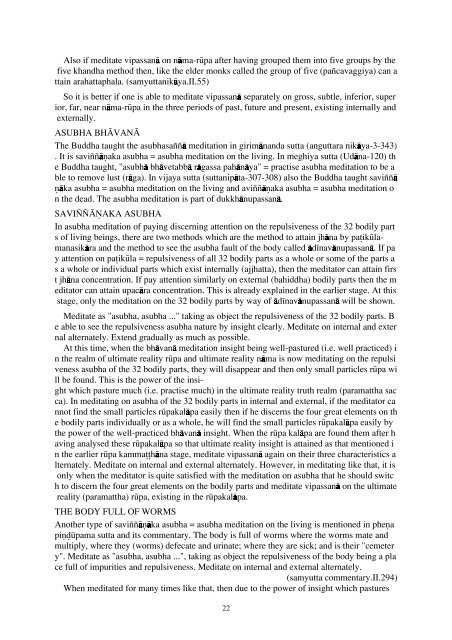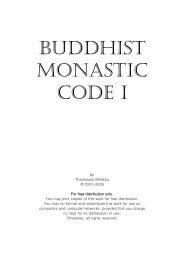Vipassana Kammatthana.pdf
Vipassana Kammatthana.pdf
Vipassana Kammatthana.pdf
You also want an ePaper? Increase the reach of your titles
YUMPU automatically turns print PDFs into web optimized ePapers that Google loves.
Also if meditate vipassanå on nåma-rËpa after having grouped them into five groups by the<br />
five khandha method then, like the elder monks called the group of five (pañcavaggiya) can a<br />
ttain arahattaphala. (samyuttanikåya.II.55)<br />
So it is better if one is able to meditate vipassanå separately on gross, subtle, inferior, super<br />
ior, far, near nåma-rËpa in the three periods of past, future and present, existing internally and<br />
externally.<br />
ASUBHA BHÓVANÓ<br />
The Buddha taught the asubhasaññå meditation in girimånanda sutta (anguttara nikåya-3-343)<br />
. It is saviññåˆaka asubha = asubha meditation on the living. In meghiya sutta (Udåna-120) th<br />
e Buddha taught, "asubhå bhåvetabbå rågassa pahånåya" = practise asubha meditation to be a<br />
ble to remove lust (råga). In vijaya sutta (suttanipåta-307-308) also the Buddha taught saviññå<br />
ˆåka asubha = asubha meditation on the living and aviññåˆaka asubha = asubha meditation o<br />
n the dead. The asubha meditation is part of dukkhånupassanå.<br />
SAVIÑÑÓÔAKA ASUBHA<br />
In asubha meditation of paying discerning attention on the repulsiveness of the 32 bodily part<br />
s of living beings, there are two methods which are the method to attain jhåna by pa ikËlamanasikåra<br />
and the method to see the asubha fault of the body called åd¥navånupassanå. If pa<br />
y attention on pa ikËla = repulsiveness of all 32 bodily parts as a whole or some of the parts a<br />
s a whole or individual parts which exist internally (ajjhatta), then the meditator can attain firs<br />
t jhåna concentration. If pay attention similarly on external (bahiddha) bodily parts then the m<br />
editator can attain upacåra concentration. This is already explained in the earlier stage. At this<br />
stage, only the meditation on the 32 bodily parts by way of åd¥navånupassanå will be shown.<br />
Meditate as "asubha, asubha ..." taking as object the repulsiveness of the 32 bodily parts. B<br />
e able to see the repulsiveness asubha nature by insight clearly. Meditate on internal and exter<br />
nal alternately. Extend gradually as much as possible.<br />
At this time, when the bhåvanå meditation insight being well-pastured (i.e. well practiced) i<br />
n the realm of ultimate reality rËpa and ultimate reality nåma is now meditating on the repulsi<br />
veness asubha of the 32 bodily parts, they will disappear and then only small particles rËpa wi<br />
ll be found. This is the power of the insight<br />
which pasture much (i.e. practise much) in the ultimate reality truth realm (paramattha sac<br />
ca). In meditating on asubha of the 32 bodily parts in internal and external, if the meditator ca<br />
nnot find the small particles rËpakalåpa easily then if he discerns the four great elements on th<br />
e bodily parts individually or as a whole, he will find the small particles rËpakalåpa easily by<br />
the power of the well-practiced bhåvanå insight. When the rËpa kalåpa are found them after h<br />
aving analysed these rËpakalåpa so that ultimate reality insight is attained as that mentioned i<br />
n the earlier rËpa kamma håna stage, meditate vipassanå again on their three characteristics a<br />
lternately. Meditate on internal and external alternately. However, in meditating like that, it is<br />
only when the meditator is quite satisfied with the meditation on asubha that he should switc<br />
h to discern the four great elements on the bodily parts and meditate vipassanå on the ultimate<br />
reality (paramattha) rËpa, existing in the rËpakalåpa.<br />
THE BODY FULL OF WORMS<br />
Another type of saviññåˆåka asubha = asubha meditation on the living is mentioned in pheˆa<br />
piˆ∂Ëpama sutta and its commentary. The body is full of worms where the worms mate and<br />
multiply, where they (worms) defecate and urinate; where they are sick; and is their "cemeter<br />
y". Meditate as "asubha, asubha ...", taking as object the repulsiveness of the body being a pla<br />
ce full of impurities and repulsiveness. Meditate on internal and external alternately.<br />
(samyutta commentary.II.294)<br />
When meditated for many times like that, then due to the power of insight which pastures<br />
22






